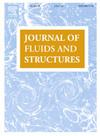Assessment of aeroelastic coupling between a shock boundary layer interaction and a flexible panel
IF 3.4
2区 工程技术
Q1 ENGINEERING, MECHANICAL
引用次数: 0
Abstract
The fluid-structural coupling between an impinging Mach 4 shock boundary layer interaction (SBLI) and a flexible panel is investigated using wall-resolved implicit large-eddy simulation (ILES). Since the prediction of fluctuating wall pressure remains a challenge in aeroelastic configurations with large flow separation regions, an exposition of the coupling processes associated with the difference in the wall pressure fields between the coupled and uncoupled interaction is sought. The distinction between the time-mean pressure, induced coherent fluctuations, and inherent pressure fluctuations is formalized using a triple decomposition. Further, the role of the time-mean aeroelastic condition is considered to delineate predominantly static and dynamic coupling mechanisms between the fluid and structure. This is achieved by computing the fluid solution over the time-mean panel deformation of the coupled interaction. The impinging shock induces a large, highly unsteady separation region, the mean and fluctuating quantities of which are augmented by the imposed aeroelastic state. The use of the time-mean aeroelastic condition as a static structural deformation in a fluid-only simulation is found to capture the mean wall pressure of the coupled condition and some, but not all, of the increased flow unsteadiness. A local piston theory model is then implemented over a portion of the panel to assess the degree of flow unsteadiness associated with classical quasi-steady fluid-structural coupling between the supersonic ensemble-mean flow and the structural dynamics. It is found that, after the flow reattachment point, the coherent, dynamically induced pressure can be linearly superimposed with the statically coupled pressure field to predict the coupled wall pressure fluctuations to a reasonable degree.
激波边界层相互作用与柔性板间气动弹性耦合的评估
利用壁面分辨隐式大涡模拟(ILES)研究了4马赫碰撞激波边界层相互作用(SBLI)与柔性板之间的流固耦合问题。由于在具有大流动分离区域的气动弹性结构中,壁压波动的预测仍然是一个挑战,因此,本文试图揭示与耦合和非耦合相互作用之间壁压场差异相关的耦合过程。时间平均压力、诱导相干波动和固有压力波动之间的区别使用三重分解形式化。此外,考虑到时间平均气动弹性条件的作用,主要描述了流体和结构之间的静态和动态耦合机制。这是通过计算耦合相互作用的时间平均面板变形的流体解来实现的。撞击冲击产生了一个大的、高度不稳定的分离区,其平均量和波动量因施加气动弹性状态而增大。在纯流体模拟中,使用时间平均气动弹性条件作为静态结构变形,可以捕获耦合条件下的平均壁面压力和部分(但不是全部)增加的流动非定常。然后在面板的一部分上实施局部活塞理论模型,以评估与超声速总体平均流动和结构动力学之间的经典准稳态流固耦合相关的流动非定常程度。研究发现,在流动再附着点之后,相干的动诱导压力可以与静耦合压力场线性叠加,在一定程度上预测耦合壁面压力波动。
本文章由计算机程序翻译,如有差异,请以英文原文为准。
求助全文
约1分钟内获得全文
求助全文
来源期刊

Journal of Fluids and Structures
工程技术-工程:机械
CiteScore
6.90
自引率
8.30%
发文量
173
审稿时长
65 days
期刊介绍:
The Journal of Fluids and Structures serves as a focal point and a forum for the exchange of ideas, for the many kinds of specialists and practitioners concerned with fluid–structure interactions and the dynamics of systems related thereto, in any field. One of its aims is to foster the cross–fertilization of ideas, methods and techniques in the various disciplines involved.
The journal publishes papers that present original and significant contributions on all aspects of the mechanical interactions between fluids and solids, regardless of scale.
 求助内容:
求助内容: 应助结果提醒方式:
应助结果提醒方式:


